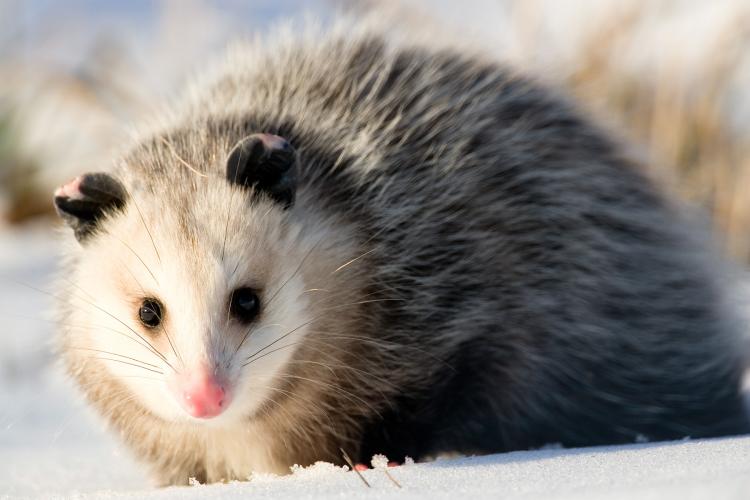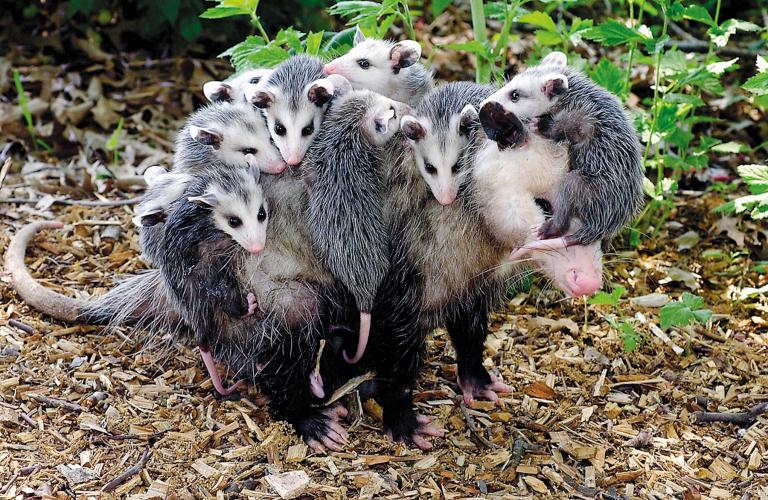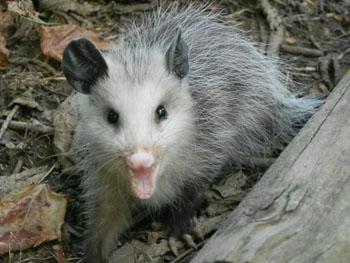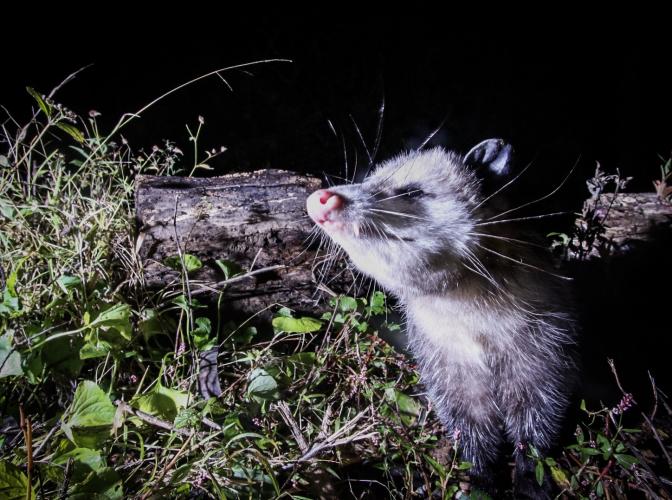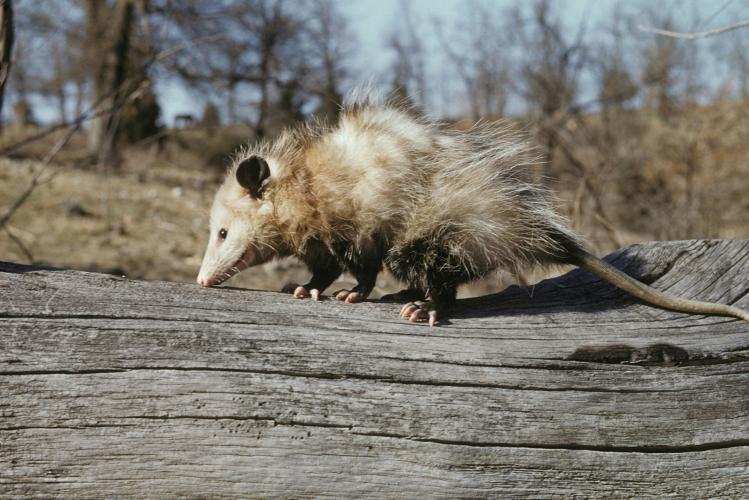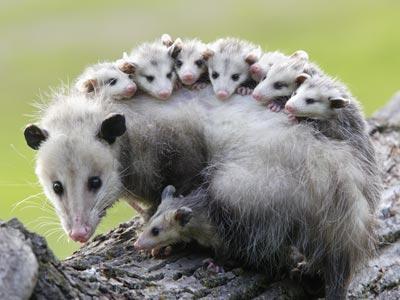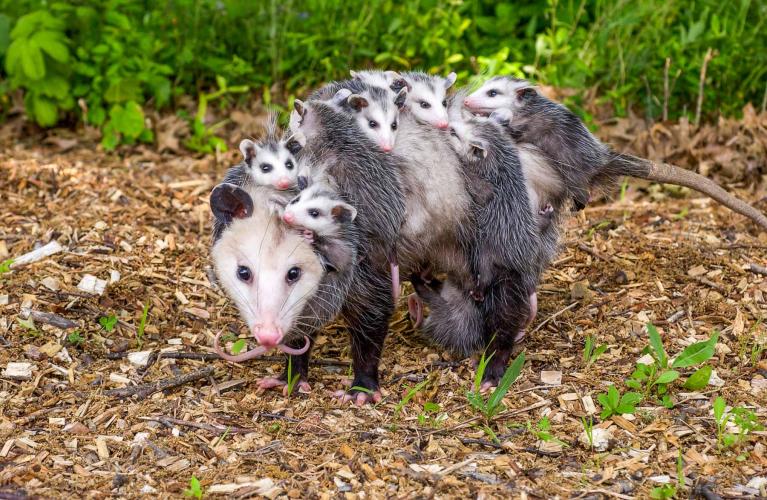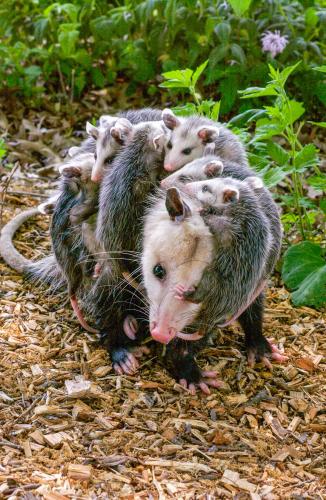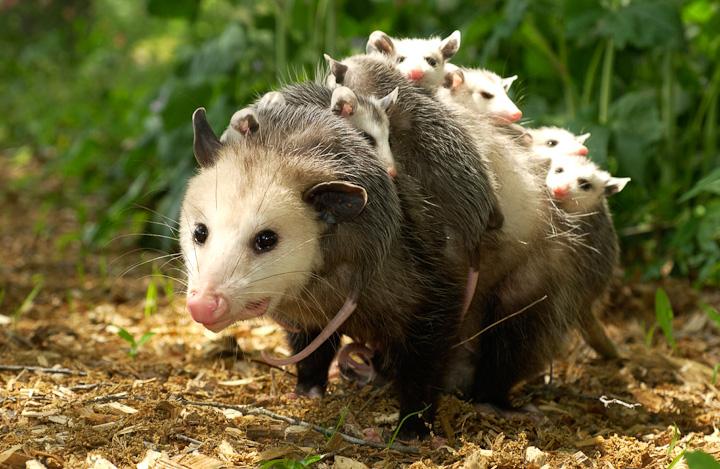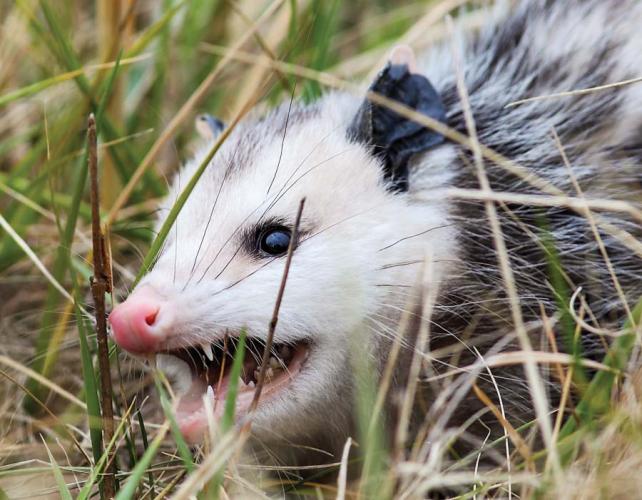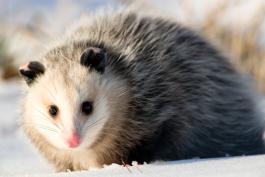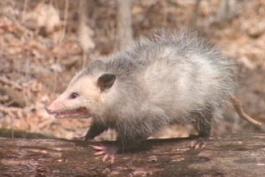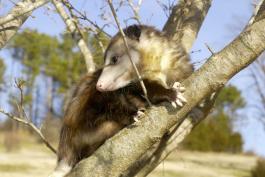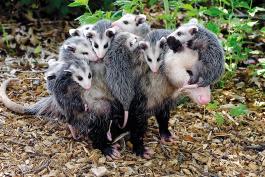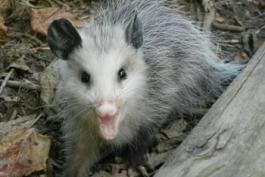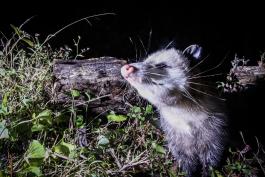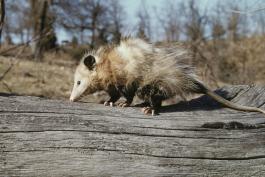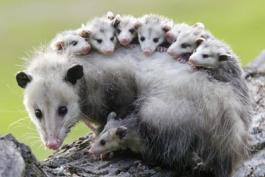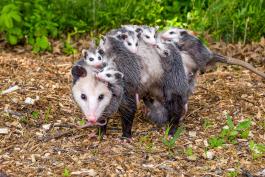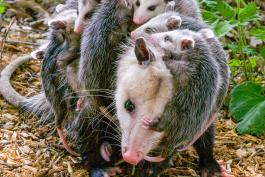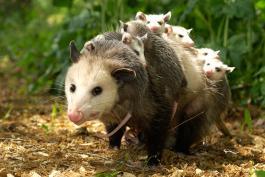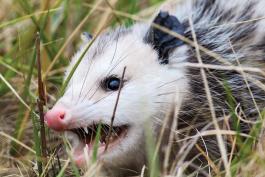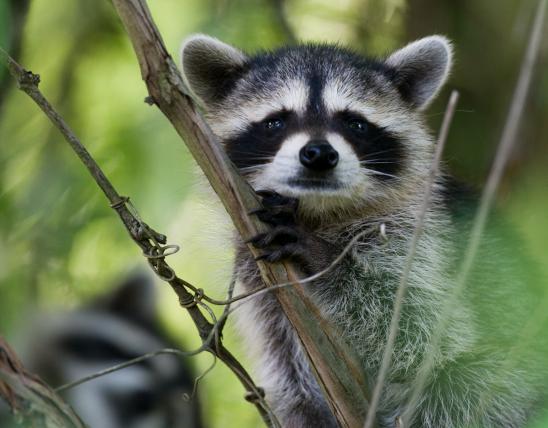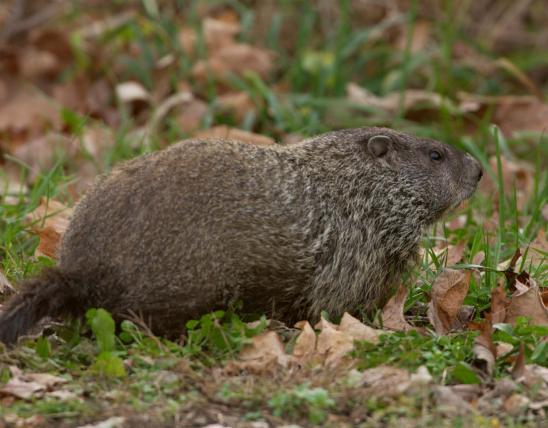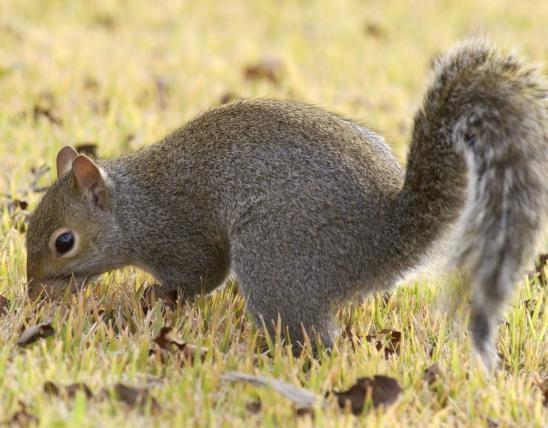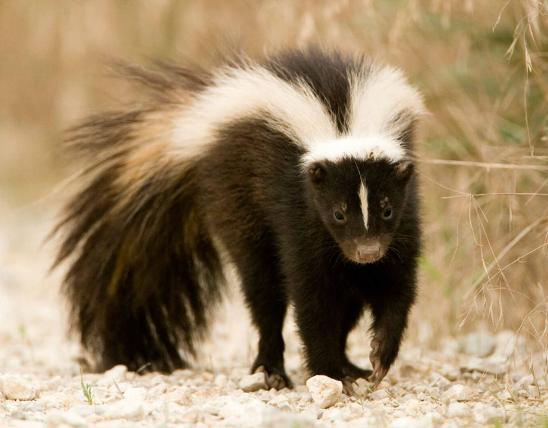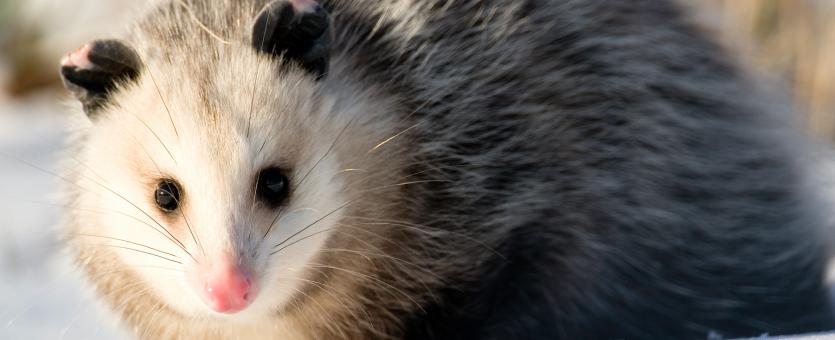
The Virginia opossum is a medium-sized mammal with long, rather coarse, grayish-white (sometimes darker) fur; a sharp, slender muzzle with a pink nose; prominent, thin, naked ears; a white or yellowish-white head; short legs; and a long, grasping tail covered with scales and scant hairs. Males and females look alike, although mature females possess a fur-lined belly pouch for carrying young, and adult males in particular often have damaged ears and tail tips due to freezing.
Similar species: The Virginia opossum is North America's only native marsupial (marsupials are mammals that raise their young in a pouch). Its closest relatives are the many species of opossums that live primarily in the rainforests of South America: red-sided opossums, short-tailed opossums, woolly opossums, slender opossums, mouse opossums, fat-tailed mouse opossums, gracile opossums, and more. Less closely related marsupials include Australian species such as kangaroos, koalas, wombats, Tasmanian devils, sugar gliders, bandicoots, and more.
Total length: 24–34 inches; tail length: 9–15 inches; weight: 4–15 pounds.
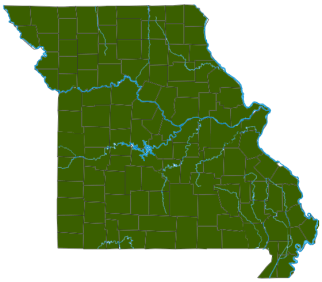
Abundant throughout the state; less abundant in the northwest and southeast regions.
Habitat and Conservation
Opossums prefer wooded areas mostly near streams, especially near farms as opposed to densely wooded areas. They are well adapted for climbing, and the thumblike opposable toe on each hind foot assists them in holding on to small branches. They can support themselves for short periods entirely by the prehensile tail if at least half of it grasps a thick branch.
Opossums are also common in urban and suburban areas.
Management includes regulated harvesting to maintain healthy populations. In Missouri, hunters and trappers may pursue this furbearer species during its prescribed season. Check the current Wildlife Code of Missouri for details.
Food
Opossums eat a variety of foods but prefer animal matter, including many types of insects, and carrion of rabbits, cats, squirrels, mice, and other animals. They also eat reptiles, amphibians, crayfish, birds and bird eggs, and earthworms. They also eat fruits, particularly in fall and early winter, such as pokeberry, grapes, persimmons, papaws, and more. Opossums are also known to scavenge food from unsecured garbage cans and pet food from bowls left outdoors.
Status
Common. Due to their abundance and adaptability, opossums do not require special management techniques and are maintained by regulated harvest. Data from recent population surveys suggest that populations are stable and increasing slightly over time.
Life Cycle
Breeding season begins in early February, and gestation only lasts 12 or 13 days. Most litters are born by the end of February. The blind, incompletely developed young are less than a half inch long; at birth they make their way to the mother’s pouch, where they nurse until they are weaned. Before they are fully weaned, the young become too large to all fit inside the pouch at once, so some will ride on their mother's back, clinging to her fur. After the first litter is ready to be weaned, typically in May, the females can mate again, with the second litters usually weaned by the end of September. Young of both sexes breed the first year after birth. Lifespan in the wild is only about 2 years. In captivity, they may live to be about 4 years old.
Control
Human Connections
Opossum fur is used in making coats, and many people enjoy baking and eating opossum. An opossum might look something like a large rat, but its life history, biology, and habits make this nocturnal mammal worthy of appreciation. What other mammal in our state can hang by its tail, “play dead,” and carry its young in a pouch?
Ecosystem Connections
Opossums feed on many insects considered injurious by farmers, and they also perform an important ecosystem function by feeding on carrion.
Opossums fall prey to foxes, coyotes, bobcats, and owls. The opossum's famous behavior of "playing dead" (or "playing possum") is a defensive adaptation. Opossums are not aggressive. If an opossum is unable to escape a predator, it first exposes its teeth and drips saliva from its mouth. If that doesn't repel the predator, the opossum rolls over on its side, becomes limp, shuts its eyes, and lets its tongue hang out of its open mouth. The heartbeat slows. This reaction apparently is a brief nervous shock similar to fainting, but the animal recovers quickly and is able to take the first opportunity for escape.
Signs and Tracks
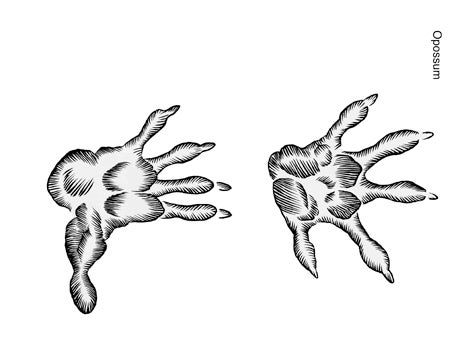
Front track:
- 2 inches long
- 5 toes, fairly evenly widespread
- track looks star-shaped.
Hind track:
- 2 inches long
- 5 toes
- thumb is at right angle; middle three together; fifth toe separate.
Other notes:
- Opossums are common throughout Missouri, especially in wooded areas.
- The hind foot is handlike, with a thumb sticking out at a right angle that does not leave a claw print.
- Often confused with raccoon tracks.
- Opossums are active in winter, while raccoons are dormant or inactive.
- The front track is often positioned beside the hind track, near the angle formed by the thumb and fingers of the hind track.
- The left and right sides are 4 inches apart.
- The distance between strides is 7 inches.
- The tail commonly leaves a track, often gently undulating, especially in snow.
